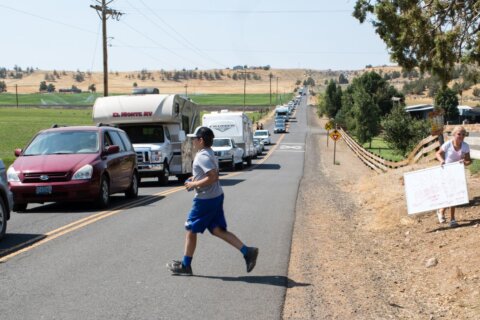WASHINGTON — Forget “Terrible Traffic Tuesday” — the term long used by D.C.-area commuters to describe the crush of traffic on the first day of work after Labor Day.
The phenomenon of congested D.C. roadways and frustrated drivers has now stretched into a monthlong commuting headache for many. Welcome to the “September surge.”
The reasons for the troublesome traffic are fairly self-evident: The kids are back to school; Congress is back in session and motorcade season is in full swing, and some tourists unfamiliar with local roadways are still in town.
“I think what we’ve seen is the evolution of the ‘terrible traffic Tuesday’ into the September surge,” said Jim Battagliese, WTOP’s director of traffic and transit operations.
Traffic the last week or so has been “absolutely horrible,” Battagliese said, and not just on the major highways. Commuters are also finding clogged secondary roads, too, he said.
“It’s everybody trying to get back into the normal workflow and they’re all doing it at the same time,” he said. “And it usually takes a few weeks for it to even out.”
By his estimate, rush-hour commutes the past two weeks are running around 15 to 30 minutes longer than average.
This year might even be worse than usual, with a planned Metro’s 24/7 track work “surge” reducing service on the Orange Line beginning Thursday and running for the next 42 days.
Metro track work, which amped up this summer as part of the agency’s “SafeTrack” initiative, presents a “wild card” for traffic conditions, Battagliese said. For example, Orange Line track work was the likely culprit for the higher-than-usual volume Thursday morning on Interstate 66, the Virginia side of the Beltway and even the Dulles Toll Road.
Evidence of terrible September traffic so far this year is mostly anecdotal.
But data from recent years backs up the hypothesis that frustrating traffic delays linger throughout the month.
Area traffic experts with the National Capital Region Transportation Planning Board call it the “September shock.”
The average jump in morning travel delays between normally-quiet August and frenetic September ranged from 15 percent in 2010 to 45 percent last year, according to an analysis released by the board last month. Those delays translated to as much as an additional half-hour spent sitting in traffic last September.
Board analysts say the annual September traffic surge is “one of the most predictable and pronounced traffic events the region sees,” and that September is easily “one of the region’s top two or three worst traffic months.”
The good news this year? An unusually dry September hasn’t dropped much rain on the region.
“How do you make traffic worse around here? You add water,” Battagliese said.
Commuters also should keep in mind their traffic woes will eventually ease somewhat.
“We see this every year, and eventually it does settle down,” he said.








